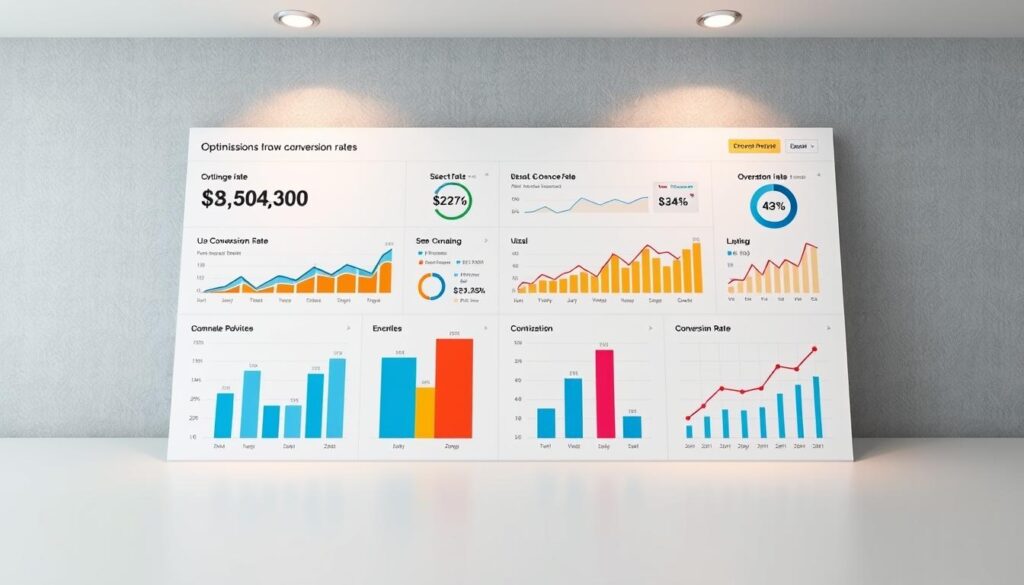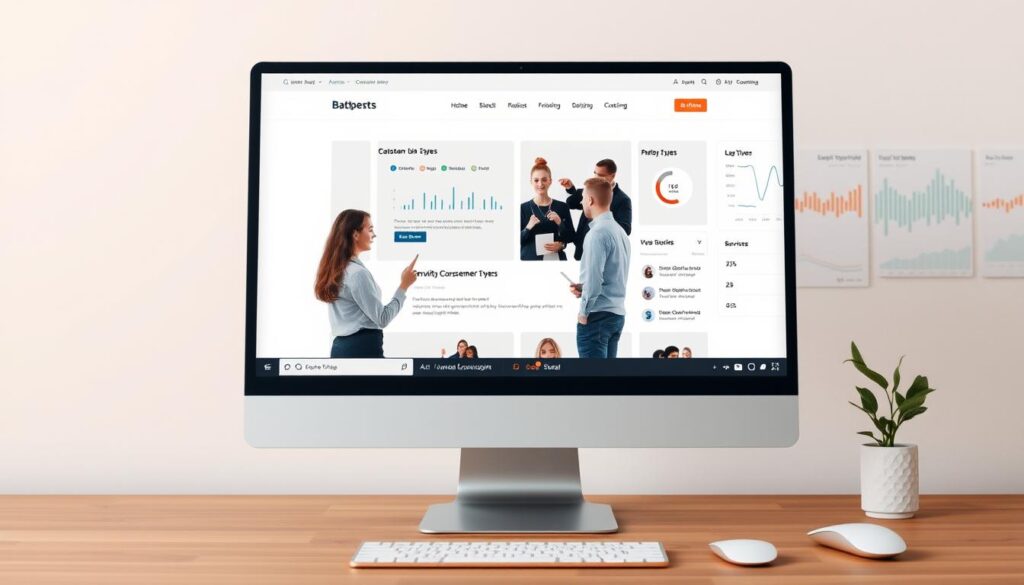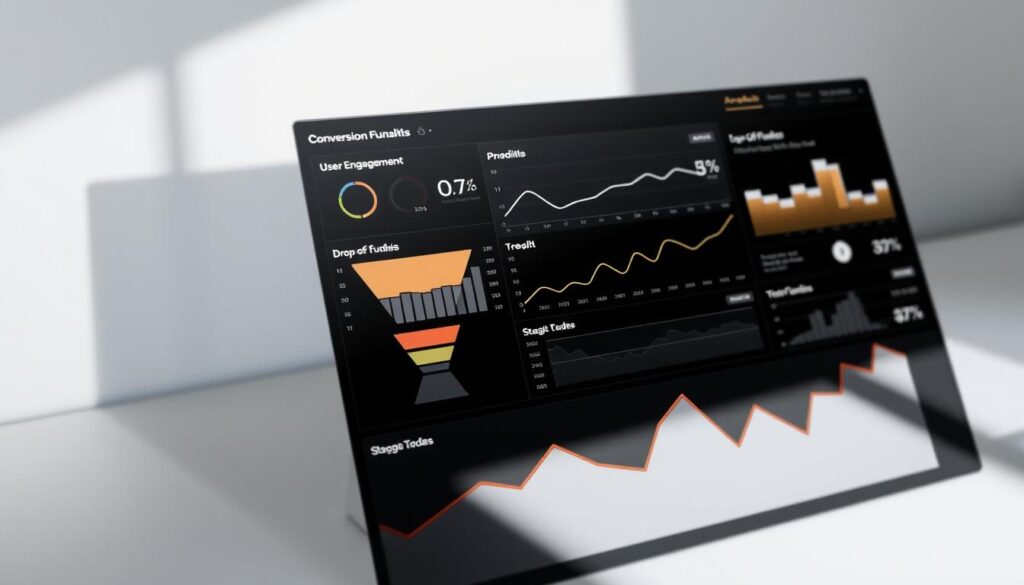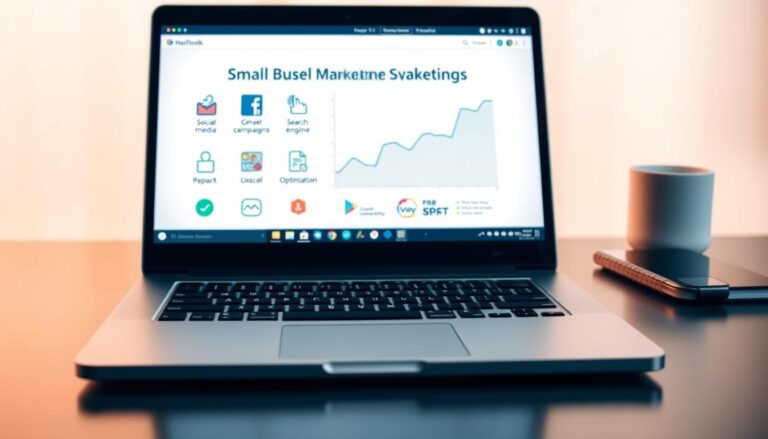Why 98% of Your Website Visitors Leave Without Converting (And How to Fix It)
Here’s a shocking reality that most business owners don’t realize: 98% of website visitors leave without becoming customers or leads. This is a huge loss of revenue that’s wasting your marketing budget.
Think about it. For every 100 people who visit your site, only 2 actually do something. The other 98 just look around and leave without a trace.
The issue goes beyond just numbers. Only 22% of businesses are happy with how their sites are doing. And here’s the kicker: they spend $92 to get visitors for every $1 they spend on conversion rate optimization.
This shows a big mistake in how most businesses use the internet. You’re trying to fill a bucket with holes. No matter how much traffic you get, most of it just slips away.
But there’s a silver lining. This problem can be fixed. With the right approach and focus on visitor engagement, you can turn your site into a money maker.
Key Takeaways
- 98% of website visitors leave without taking any action or converting
- Most businesses spend 92 times more on traffic acquisition than on improving conversions
- Only 22% of companies are satisfied with their current website performance
- Poor visitor engagement is the primary cause of high bounce rates
- Conversion optimization problems are completely solvable with proper strategies
- Small improvements in conversion rates can lead to massive revenue increases
The Shocking Reality Behind Low Website Conversion Rates
Every day, millions of people visit websites but don’t buy anything. This is a huge problem that’s costing your business a lot of money.
Studies show that 70% of website visitors who leave never return. That means seven out of ten people who find your site will never come back if you don’t grab their attention right away.
The bounce rate across industries is really bad. Most sites see 40% to 60% of visitors leave quickly. This means nearly half of your visitors leave in seconds.

Research shows that 40% of visitors stop engaging if they find your content confusing. Another 50% can’t find what they need fast enough.
Let’s look at an example. If your site gets 1,000 visitors a month and 1% convert, you get 10 customers. The other 990 visitors are missed chances to make money.
Psychological factors play a big role too. Visitors decide to stay or leave in the first 8 seconds. They check if your content is relevant, if your site looks professional, and if they can find what they need quickly.
Knowing industry benchmarks helps you see how you compare. Here’s a table showing bounce rates for different industries:
| Industry | Average Bounce Rate | Conversion Rate Range | Revenue Impact |
|---|---|---|---|
| E-commerce | 45-55% | 2-3% | High |
| Professional Services | 50-65% | 3-5% | Medium |
| SaaS/Technology | 35-45% | 5-7% | Very High |
| Healthcare | 55-70% | 1-2% | Medium |
Poor conversion rate optimization costs more than just immediate sales. You also lose:
- Future referral opportunities from satisfied customers
- Valuable customer data and insights
- Brand awareness and market positioning
- Return on your marketing investments
First impressions are key. People judge your website’s credibility in 50 milliseconds. This first impression affects all their interactions with your site.
Trust signals are important too. Visitors look for signs that your business is trustworthy. Weak trust signals can make them leave fast, raising your bounce rate.
Cognitive load also matters. Too much information or confusing navigation can make visitors tired. They might leave to find something easier.
The mobile experience is critical. With over 60% of traffic coming from mobiles, poor mobile optimization can instantly eliminate half your customers.
These stats aren’t meant to scare you. They show a big opportunity for improvement. Small changes in conversion rate can make a big difference. Even a 1% increase in conversion rate can double your revenue from the same traffic.
Five Critical Reasons Your Visitors Leave Without Converting
Your website might be pushing visitors away without you realizing it. 95% of visitors engage more with good user experience websites. Yet, many business owners unknowingly create obstacles that drive customers away. Understanding these barriers can turn your website into a powerful sales machine.
Technical issues, poor messaging, and aesthetic problems are the main reasons people leave websites. Each barrier creates friction, making visitors doubt your business. Let’s look at these issues and find ways to fix them.
Poor User Experience Destroys First Impressions
Your website has less than three seconds to make a good first impression. Poor user experience signals unprofessionalism and doubt. Cluttered layouts overwhelm visitors, making it hard to focus on your message.
Mobile-unfriendly designs frustrate 60% of users who browse on phones. Small text and tiny buttons make visitors leave for competitors with better mobile sites. Confusing interfaces make visitors work too hard to find information.

Visual hierarchy problems confuse visitors about what’s important. Without clear focal points, visitors feel lost. Professional design isn’t just about looks – it’s about guiding visitors smoothly toward conversion.
Slow Loading Times Kill Visitor Patience
Website speed is critical, with even a one-second delay costing 7% of conversions. Modern consumers expect fast websites. Slow sites suggest technical incompetence and harm your brand.
Large images, too many plugins, and poor hosting choices slow down websites. Every second of delay increases bounce rates. Mobile users are even more impatient, often leaving sites that take too long to load.
Page speed affects more than just visitor engagement. It also impacts your search engine rankings. Google favors fast-loading sites, so slow sites lose visitors and organic traffic.
Missing Trust Signals Create Doubt
Visitors need reassurance before sharing personal info or making purchases. Missing trust signals make them doubt your legitimacy. Without visible security badges, testimonials, or credentials, they assume the worst.
Social proof like customer reviews and client logos build confidence. Professional presentation and clear contact info humanize your business. These elements reduce perceived risk.
- Security badges from recognized providers like Norton or McAfee
- Customer testimonials with photos and specific details
- Money-back guarantees that reduce purchase anxiety
- Professional certifications relevant to your industry
- Clear contact information including phone numbers and addresses
Trust signals must be visible where visitors make decisions. Hidden information fails to influence visitor behavior when it matters most.
Weak Value Propositions Fail to Convince
Your value proposition answers the question: “Why choose you over competitors?” Weak value propositions fail to differentiate your business. Generic statements like “quality service” or “competitive prices” don’t persuade.
Studies show that 80% of small B2B business websites lack a clear call-to-action. Without compelling reasons to engage, visitors move on to competitors. Effective value propositions address specific customer pain points and promise concrete solutions.
Your messaging must immediately communicate what makes your business special. Visitors shouldn’t have to search for reasons to choose your products or services. Clear, benefit-focused language resonates more than feature-heavy descriptions.
Confusing Navigation Frustrates Users
Complex navigation systems create unnecessary friction. When visitors can’t find important information quickly, they leave for competitors. Confusing navigation suggests disorganization and poor attention to customer needs.
Research indicates that 90% of visitors will only view the first slide of website carousels. Yet, many businesses bury important information in rotating banners. Overly complex menu structures and inconsistent navigation patterns confuse visitors and delay decision-making.
- Limit main menu items to seven or fewer options
- Use descriptive labels instead of creative but unclear terms
- Maintain consistent navigation across all pages
- Include search functionality for content-heavy websites
- Create clear pathways to your most important pages
Effective navigation anticipates visitor needs and provides logical pathways to desired information. Every click should move visitors closer to conversion. Simplicity trumps creativity when it comes to helping visitors find what they’re seeking.
These five conversion killers work together to create compounding negative effects on visitor engagement. Addressing each barrier systematically transforms your website into a conversion-generating asset that grows your business.
How to Identify Conversion Funnel Bottlenecks
Using data to make decisions is key for a successful website. 70% of marketers believe data will guide their choices. It’s time to stop making changes without knowing why. You need to track where visitors leave your site.
Without data, you’re guessing in the dark. Every site has spots where visitors get lost or lose interest. The difference between success and struggle is finding and fixing these spots.

Tracking Bounce Rate Patterns Across Pages
Your bounce rate tells a story about how visitors act on each page. Start by looking at Google Analytics for high bounce rates. Pages with rates over 70% need urgent attention.
Break down your traffic by source to see different behaviors. Visitors from organic search have different needs than those from social media or ads. This helps you spot specific problems for each group.
Pages where visitors leave quickly often have issues. Look for pages where visitors spend less than 30 seconds. These are likely due to bad content, slow loading, or confusing design. Make a list of your busiest pages with high bounce rates first.
Finding Drop-off Points in Your Customer Journey
Tools like Hotjar or Crazy Egg show where visitors click and leave. These tools reveal hidden barriers that analytics can’t catch.
Use Google Analytics to track your conversion funnel. Find out where most visitors drop off. Improving just 10% at your biggest drop-off point can make a big difference.
Watching user session recordings gives you a detailed look at visitor behavior. See where they pause and why they leave. This qualitative data helps you understand the reasons behind your problems.
Focus on fixing the most critical pages first. Start with high-traffic pages with big drop-offs. Then, tackle smaller issues. This method ensures you’re using your time and resources wisely.
Essential Conversion Rate Optimization Techniques That Work
Smart conversion rate optimization techniques work for all businesses. They help boost your bottom line. These methods deliver measurable results when applied to your website.
Effective optimization works for everyone, big or small. You don’t need a lot of money or technical skills to see results. These techniques improve your website’s performance.
Strategic A/B Testing for Maximum Impact
A/B testing is key to successful optimization. It compares two webpage versions to see which works better. You can test many things like headlines and button colors.
Start with big changes like your main headline. It’s the first thing visitors see. Then test your primary call-to-action button. Focus on one element at a time for clear results.
It’s important to wait for enough data. Aim for at least 95% confidence level. This means collecting data from hundreds of visitors. Quick results can lead to bad decisions.
- Test duration: Run tests for at least one full business cycle
- Sample size: Aim for 1,000+ visitors per variation
- Success metrics: Track conversions, not just clicks
- Documentation: Record all test results for future reference
Optimizing Call-to-Action Buttons for Higher Clicks
Your call-to-action buttons are key to conversions. Small changes can make a big difference. They improve your user experience and conversion rates.
Color psychology is important for buttons. Orange and red buttons often work better than blue or green. But, your button color should contrast well with your page background. Visibility trumps color theory every time.
Button copy is as important as design. Use action-oriented text instead of generic phrases. Phrases like “Get My Free Quote” create clear expectations.
Size and placement are critical. Make buttons big enough for mobile devices. Place your main button above the fold for immediate visibility. Secondary buttons should be smaller and less prominent.
- Use contrasting colors that stand out from your page design
- Write specific, action-oriented copy that tells visitors what they’ll get
- Make buttons mobile-friendly with adequate size and spacing
- Test different positions to find the most effective placement
Simplifying Your Checkout and Form Processes
Complex checkout processes kill conversions. Every extra field reduces completion rates. Conversion rate optimization experts say to use the fewest fields needed.
Remove optional fields from your initial form. Collect more info later through email or surveys. Focus on the essential data for processing the order or inquiry.
Form design affects completion rates. Use single-column layouts and clear labels. Provide helpful error messages and show progress indicators for multi-step processes.
Guest checkout options reduce abandonment for e-commerce sites. Many visitors leave when forced to create accounts. Offer account creation as an optional step after purchase.
- Minimize required fields to only essential information
- Use clear, descriptive labels for all form elements
- Provide real-time validation to catch errors immediately
- Offer multiple payment options to accommodate different preferences
- Display security badges near payment forms to build trust
These optimization techniques work because they remove friction. When you make it easier for people to take action, more will. Start with A/B testing to find big opportunities, then improve each element of your conversion process.
Proven Methods to Increase Visitor Engagement
Your website has just eight seconds to grab a visitor’s attention. This short time makes visitor engagement key to success. Studies show that 40% of visitors leave if they find your content confusing or irrelevant in those first moments.
To turn casual browsers into engaged prospects, you need to understand user psychology. Strategic design choices help visitors connect with your content. When they feel connected and can easily find what they need, they move through your conversion funnel with more confidence.
Crafting Compelling Above-the-Fold Content
Above-the-fold content is your website’s first impression. It decides if visitors scroll down or leave. This area must quickly show your value and address your audience’s main concerns.
Your headline should clearly state what you offer and its benefits. Avoid confusing terms or clever wordplay. Use direct, benefit-driven language that meets your audience’s needs.
Supporting elements like subheadings and bullet points should back up your main message. Include a clear call-to-action button. Adding a testimonial or trust indicator can also help build credibility right away.
- Clear value proposition – State your unique benefit in 10 words or less
- Compelling headline – Address the visitor’s primary concern or desire
- Supporting subheading – Expand on your headline with additional context
- Visible call-to-action – Use contrasting colors and action words
- Trust indicators – Display logos, testimonials, or security badges
Using Visual Design to Guide User Behavior
Visual design subtly guides visitors toward your desired actions. Colors, whitespace, and layout choices affect user behavior on a subconscious level. This makes design psychology a powerful tool for improving visitor engagement.
Visual hierarchy helps visitors process information in the order you want. Use larger fonts for headlines, contrasting colors for buttons, and whitespace to make elements stand out. This reduces cognitive load and makes decisions easier for visitors.
Directional cues like arrows or eye-gaze direction in photos can guide attention. Using these techniques as part of conversion rate optimization strategies creates a natural flow through your content.
- Establish visual hierarchy through font sizes, colors, and positioning
- Use contrasting colors to make important elements stand out
- Apply directional cues to guide eyes toward key conversion points
- Create logical flow from headline to call-to-action
- Minimize distractions by removing unnecessary elements
Mobile-First Optimization Strategies
With about 50% of website traffic coming from mobile devices, mobile optimization is key. Mobile users behave differently, requiring specific design considerations. This affects your ability to keep visitor engagement across all platforms.
Touch-friendly design is essential for mobile optimization. Buttons and clickable elements should be large and spaced well to avoid accidental clicks. Navigation menus should be simple and easy to access.
Mobile users expect fast loading times. Compress images, minimize code, and prioritize above-the-fold content to keep them engaged. Consider adding progressive web app features for a better mobile experience.
Optimizing the conversion funnel for mobile requires shorter forms and streamlined checkout processes. Auto-fill capabilities and single-click purchasing options can make mobile interactions quicker and more efficient.
- Responsive design – Ensure consistent experience across all screen sizes
- Touch-optimized elements – Make buttons and links easy to tap
- Fast loading times – Optimize images and minimize code for speed
- Simplified navigation – Use clear, accessible menu structures
- Mobile-friendly forms – Reduce fields and enable auto-fill features
Building Instant Trust and Credibility
Your website has just seconds to show visitors it’s trustworthy. Without trust signals, even interested people might hesitate. Smart businesses know that building credibility is key to improving their conversion rates and user experience.
Trust barriers are a big obstacle in turning website visitors into customers. Research shows 61% of consumers won’t buy from sites without trust indicators. So, your strategy must focus on credibility-building elements that address visitor concerns right away.
Leveraging Customer Reviews and Social Proof
Customer reviews and testimonials are powerful trust builders. Social proof works because people trust others’ experiences when choosing unfamiliar businesses.
Show customer reviews on your homepage and product pages. Include details like customer names, locations, and photos. Video testimonials are even more convincing because they feel more real.
Case studies show your problem-solving ability. Use clear before-and-after scenarios to highlight results. This approach improves user experience by showing how your solution works in real life.
Third-party review platforms like Google Reviews add credibility. Display your ratings and link to these platforms. This transparency builds trust because visitors can check reviews themselves.
Consider adding these social proof elements:
- Customer count displays (“Join 10,000+ satisfied customers”)
- Recent activity notifications (“5 people bought this in the last hour”)
- Industry awards and certifications
- Media mentions and press coverage
- Client logos from recognizable companies
Displaying Security Badges and Money-Back Guarantees
Security concerns stop many from buying online. Trust badges and security certificates show you protect customer info.
SSL certificates are vital for sites collecting personal info. Display security badges from Norton, McAfee, or Trustpilot near checkout forms. These badges show your site is secure.
Money-back guarantees remove risk and encourage buyers. Risk reversal strategies shift risk from the customer to your business. Clearly state your guarantee terms and make them easy to find.
Payment security badges from credit card companies and payment processors like PayPal or Stripe build more confidence. Display these logos near checkout to reassure customers about payment safety. This simple step can greatly improve your conversion rate.
Consider these guarantee types:
- 30-day money-back guarantees
- Free trial periods
- Satisfaction guarantees
- Price matching policies
- Extended warranty options
Creating Professional Brand Presentation
Your website’s design shows professionalism before visitors read anything. Professional presentation builds instant credibility and makes a positive first impression.
Consistent branding across all pages shows attention to detail and stability. Use the same colors, fonts, and logo placement. This consistency makes your site look cohesive and professional.
High-quality images and graphics reflect your business standards. Avoid generic or outdated stock photos. Instead, use custom photography or premium stock images that match your brand. Poor visual quality can undermine credibility.
Clear contact information shows you’re a real business with real people. Include your physical address, phone number, and business hours. An “About Us” page with team photos and company history adds a personal touch.
Professional copywriting without errors shows competence. Poor writing suggests carelessness. Invest in quality content that reflects your expertise and attention to detail.
| Trust Element | Impact on Conversions | Implementation Difficulty | Cost Level |
|---|---|---|---|
| Customer Reviews | High (18% average increase) | Medium | Low |
| Security Badges | Medium (8% average increase) | Easy | Low |
| Money-Back Guarantee | High (15% average increase) | Easy | Medium |
| Professional Design | Very High (25% average increase) | Hard | High |
Building trust requires combining multiple credibility signals. Focus on the elements most relevant to your audience and business. Remember, trust-building is an ongoing process that supports long-term success.
Conclusion
Your website’s high bounce rate doesn’t have to last forever. The strategies in this guide can turn your 98% visitor abandonment into real business growth. This means more conversions and success for your site.
Companies like Amazon show how design choices can make a big difference. They use big “Add to Cart” buttons and plenty of white space to boost sales. PearlsOnly saw a 10% revenue increase just by improving their checkout process. These examples show that small tweaks can lead to big results.
Begin with the most impactful changes first. Make your pages load faster, as a one-second delay can cut conversions by a lot. Add social proof to keep visitors engaged. Also, make your forms and checkout easier to use.
Remember, improving conversions is a continuous effort. Test one thing at a time and track your results. Keep what works and ditch what doesn’t. ADT saw a 60% increase in conversions just by changing their call-to-action text.
You now have the tools to turn your website visitors into customers. Focus on making your site better for users before spending more on ads. Your current visitors are a goldmine of untapped revenue, waiting for better conversion strategies.
The journey from visitor to customer begins with your next improvement. Start today and watch your conversion rates soar while your bounce rate falls.






